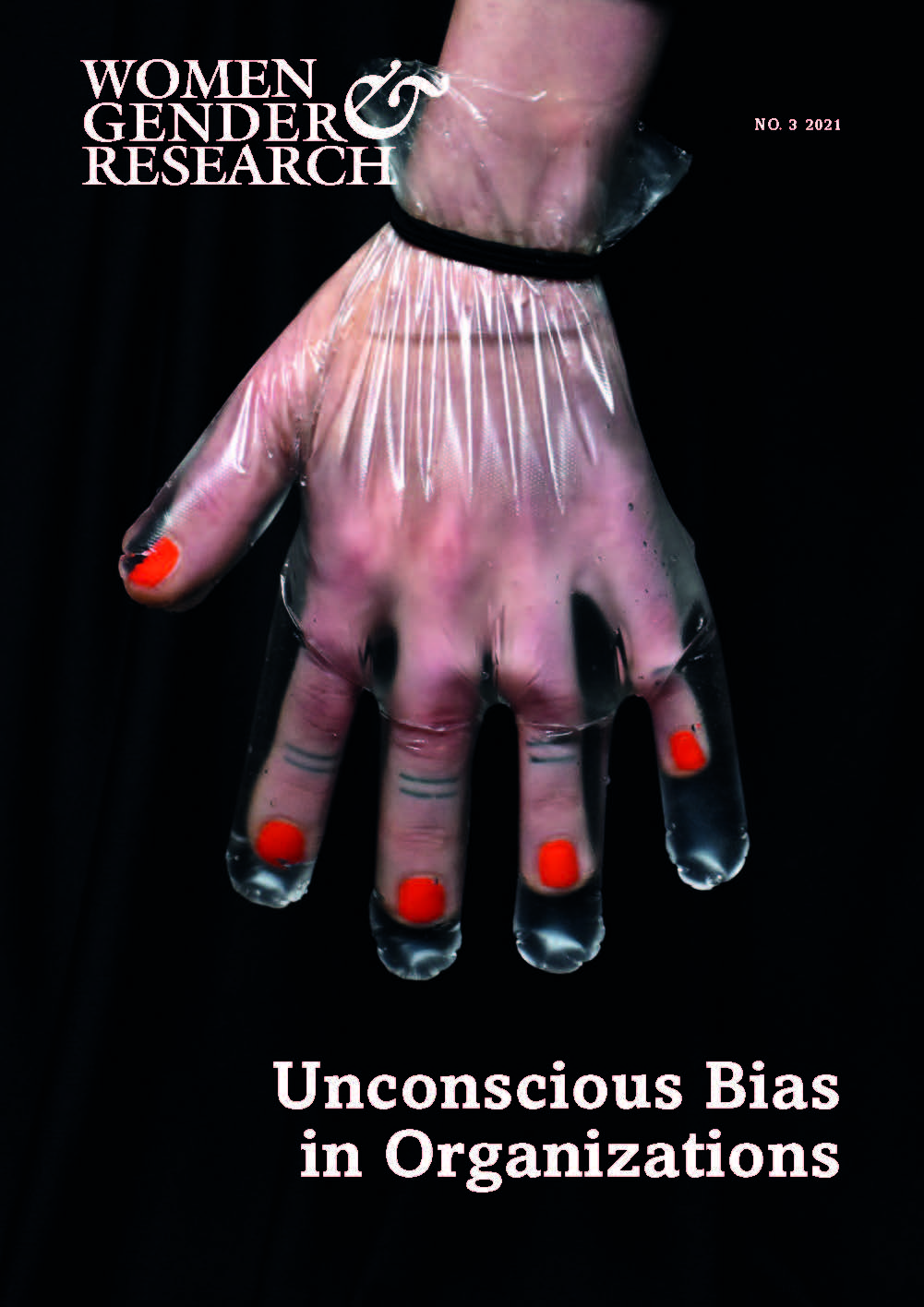Unconscious bias in organizations
Discriminatory forces at work
DOI:
https://doi.org/10.7146/kkf.v32i3.129751Nøgleord:
unconscious bias, implicit bias, discrimination, discriminatory, organizationResumé
This special issue revolves around the topic of unconscious bias in organizations. The six articles included draw on diverse disciplinary, theoretical, and methodological approaches to show how unconscious bias play out in organizational settings and how they lead to various forms of discrimination. The articles contribute to the current bias literature by (1) elevating the idea of bias from individualist perspectives toward more contextual considerations, (2) drawing on multiple perspectives from different research fi elds and thereby creating a more interdisciplinary understanding, (3) considering unconscious and discriminatory gender bias in intersection with other markers of social inequality, and (4) by reframing current understandings of bias in organizations toward a more actionable and change-oriented perspective. To conclude, the special issue illustrates novel approaches to and discussions on the matter of investigating bias at the root of discrimination in organizations.
Referencer
Ashcraft, K. L. 2013. The Glass Slipper: “Incorporating” Occupational Identity in Management Studies. Academy of Management Review. 38 (1), 6-31.
Ashcraft, K. L., Muhr, S. L., Rennstam, J. and Sullivan, K. 2012. Professionalization as a Branding Activity: Occupational Identity and the Dialectic of Inclusivity-exclusivity. Gender, Work & Organization, 19 (5),467-488.
Acker, J. 1990. Hierarchies, Jobs, Bodies: A Theory of Gendered Organizations. Gender & Society. 4 (2), 139-158.
Bargh, J. A. and Chartrand, T. L. 1999. The Unbearable Automaticity of Being. American Psychologist. 54 (7), 462.
Bendl, R., Bleijenbergh, I., Henttonen, E. and Mills, A. J. (Eds.). 2015. The Oxford Handbook of Diversity in Organizations. Oxford: Oxford University Press.
Brewis, J., Hampton, M. P. and Linstead, S. 1997. Unpacking Priscilla: Subjectivity and Identity in the Organization of Gendered Appearance. Human Relations. 50 (10), 1275-1304.
Britton, D. M. 2000. The Epistemology of the Gendered Organization. Gender & Society. 14 (3), 418-434.
Carlsson, M. and Rooth, D. O. 2000. Evidence of Ethnic Discrimination in the Swedish Labor Market using Experimental Data. Labor Economics. 14, 716-729.
Danowitz, M. A., Hanappi-Egger, E., and Mensi-Klarbach, H. (Eds.). 2012. Diversity in Organizations: Concepts and Practices. Basingstoke: Macmillan International Higher Education.
Deane, B. R. 2013. Diversity at Work: The Practice of Inclusion (Vol. 33). John Wiley & Sons.
Einarsdó ttir, A., Hoel, H. and Lewis, D. 2016. Fitting the Bill?(Dis) embodied Disclosure of Sexual Identities in the Workplace. Work, Employment and Society. 30 (3), 489-505.
Fine, C. 2013. Delusions of Gender: How our Minds, Society and Neurosexism Create Differences. New York: W.W. Norton & Company.
Fine, C. 2018. Testosterone Rex: Myths of Sex, Science and Society. New York: W.W. Norton & Company.
Gaustad, T. and Raknes, K. 2015. Menn som ikke Liker Karrierekvinner: Hovedresultater fra en Eksperimentell Undersøgelse. Norge: Markedshøyskolen og Tankesmien Agenda.
Hassin, R. R., Uleman, J. S. and Bargh, J. A. 2005. The New Unconscious (Vol. 1). Oxford: Oxford University Press.
Heilman, M. and Caleo, S. 2018. Combatting Gender Discrimination: A Lack of Fit Framework. Group Processes and Intergroup Relations. 21 (5), 725-744.
Martin, P. Y. and Collinson, D. 2002. ‘Over the Pond and Across the Water’: Developing the fi eld of ‘Gendered Organizations.’ Gender, Work & Organization. 9 (3), 244-265.
Monaghan, L. F. 2002. Embodying Gender, Work and Organization: Solidarity, Cool Loyalties and Contested Hierarchy in a Masculinist Occupation. Gender, Work & Organization. 9 (5), 504-536.
Moss-Racusin, C. A., Dovidio, J. F., Brescoll, V. L., Graham, M. and Handelsman, J. 2012. Science Faculty’s Subtle Gender Biases Favor Male Students. PNAS: Proceedings of the National Academy of Sciences for the United States of America, nr. 109 (41), 16474-16479.
Muhr, S. L. 2011. Caught in the Gendered Machine: On the Masculine and Feminine in Cyborg Leadership. Gender, Work and Organization. 18 (3), 337-357.
Muhr, S. L. and Sullivan, K. R. 2013. “None so Queer as Folk”: Gendered Expectations and Transgressive Bodies in Leadership. Leadership. 9 (3), 416-435.
Rippon, G. 2019. The Gendered Brain: The New Neuroscience that Shatters the Myth of the Female Brain. London: Penguin Random House.
Sabharwal, M. 2014. Is Diversity Management Suffi cient? Organizational Inclusion to Further Performance. Public Personnel Management. 43 (2), 197-217.
Saini, A. 2018. How Science got Women Wrong and the New Research that’s Rewriting the Story. London: 4th Estate.
Smith, N. and Parrotta, P. 2018. Why so Few Women on Boards of Directors? Empirical Evidence from Danish Companies in 1998-2010. Journal of Business Ethics. 147 (2), 445-467.
Staunæs, D. 2005. From Culturally Avant-garde to Sexually Promiscuous: Troubling Subjectivities and Intersections in the Social Transition from Childhood to Youth. Feminism and Psychology. 15 (2), 149-167.
Trix, F. and Psenka, C. 2003. Exploring the Color of Glass: Letters of Recommendation for Female and Male Medical Faculty. Discourse & Society. 14 (2), 191-220.
West, C. and Fenstermaker, S. (1995). Doing difference. Gender & Society, 9 (1), 8-37.
Williams, J. C. 2015. The 5 biases pushing women out of STEM. https://hbr.org/2015/03/the-5-biasespushing-women-out-of-stem. Harvard Business Review. March 24.
Downloads
Publiceret
Citation/Eksport
Nummer
Sektion
Licens

Dette værk er under følgende licens Creative Commons Navngivelse –Ikke-kommerciel (by-nc).
Udgivelser i Kvinder, Køn og Forskning er beskyttet under Creative Commons License: CC Attribution-NonCommercial 4.0

